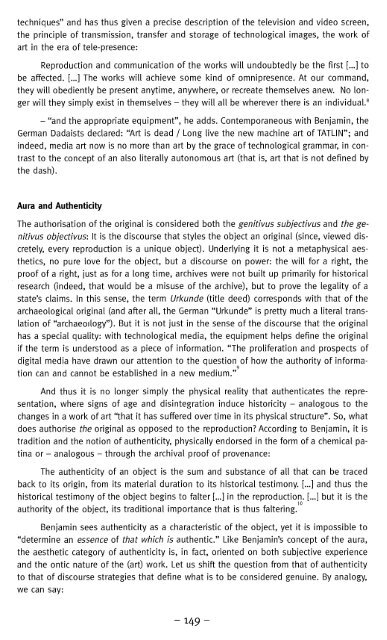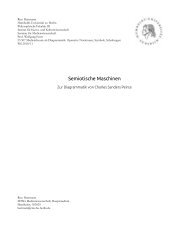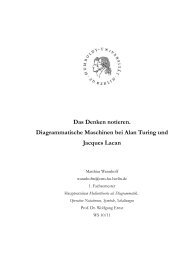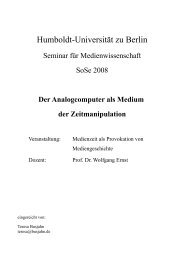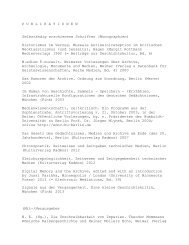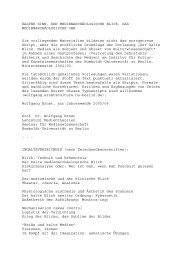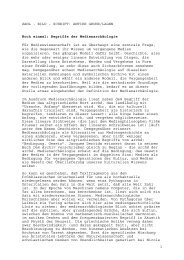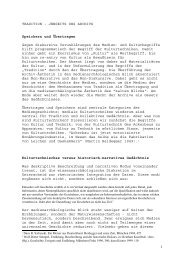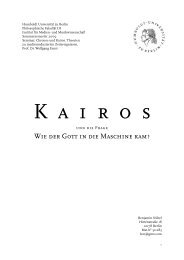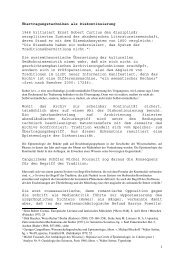Download - Medienwissenschaft
Download - Medienwissenschaft
Download - Medienwissenschaft
Create successful ePaper yourself
Turn your PDF publications into a flip-book with our unique Google optimized e-Paper software.
techniques" and has thus given a precise description of the television and video screen,<br />
the principle of transmission, transfer and storage of technological images, the work of<br />
art in the era of tele-presence:<br />
Reproduction and communication of the works will undoubtedly be the first [...] to<br />
be affected. [...] The works will achieve some kind of omnipresence. At our command,<br />
they will obediently be present anytime, anywhere, or recreate themselves anew. No longer<br />
will they simply exist in themselves - they will all be wherever there is an individual. 8<br />
- "and the appropriate equipment", he adds. Contemporaneous with Benjamin, the<br />
German Dadaists declared: "Art is dead / Long live the new machine art of TATLIN"; and<br />
indeed, media art now is no more than art by the grace of technological grammar, in contrast<br />
to the concept of an also literally autonomous art (that is, art that is not defined by<br />
the dash).<br />
Aura and Authenticity<br />
The authorisation of the original is considered both the genitivus subjectivus and the genitivus<br />
objectivus: It is the discourse that styles the object an original (since, viewed discretely,<br />
every reproduction is a unique object). Underlying it is not a metaphysical aesthetics,<br />
no pure love for the object, but a discourse on power: the will for a right, the<br />
proof of a right, just as for a long time, archives were not built up primarily for historical<br />
research (indeed, that would be a misuse of the archive), but to prove the legality of a<br />
state's claims. In this sense, the term Urkunde (title deed) corresponds with that of the<br />
archaeological original (and after all, the German "Urkunde" is pretty much a literal translation<br />
of "archaeoilogy"). But it is not just in the sense of the discourse that the original<br />
has a special quality: with technological media, the equipment helps define the original<br />
if the term is understood as a piece of information. "The proliferation and prospects of<br />
digital media have drawn our attention to the question of how the authority of informa-<br />
9<br />
tion can and cannot be established in a new medium."<br />
And thus it is no longer simply the physical reality that authenticates the representation,<br />
where signs of age and disintegration induce historicity - analogous to the<br />
changes in a work of art "that it has suffered over time in its physical structure". So, what<br />
does authorise the original as opposed to the reproduction? According to Benjamin, it is<br />
tradition and the notion of authenticity, physically endorsed in the form of a chemical patina<br />
or - analogous - through the archival proof of provenance:<br />
The authenticity of an object is the sum and substance of all that can be traced<br />
back to its origin, from its material duration to its historical testimony. [...] and thus the<br />
historical testimony of the object begins to falter [...] in the reproduction. [...] but it is the<br />
10<br />
authority of the object, its traditional importance that is thus faltering.<br />
Benjamin sees authenticity as a characteristic of the object, yet it is impossible to<br />
"determine an essence of that which is authentic." Like Benjamin's concept of the aura,<br />
the aesthetic category of authenticity is, in fact, oriented on both subjective experience<br />
and the ontic nature of the (art) work. Let us shift the question from that of authenticity<br />
to that of discourse strategies that define what is to be considered genuine. By analogy,<br />
we can say:<br />
-149-


